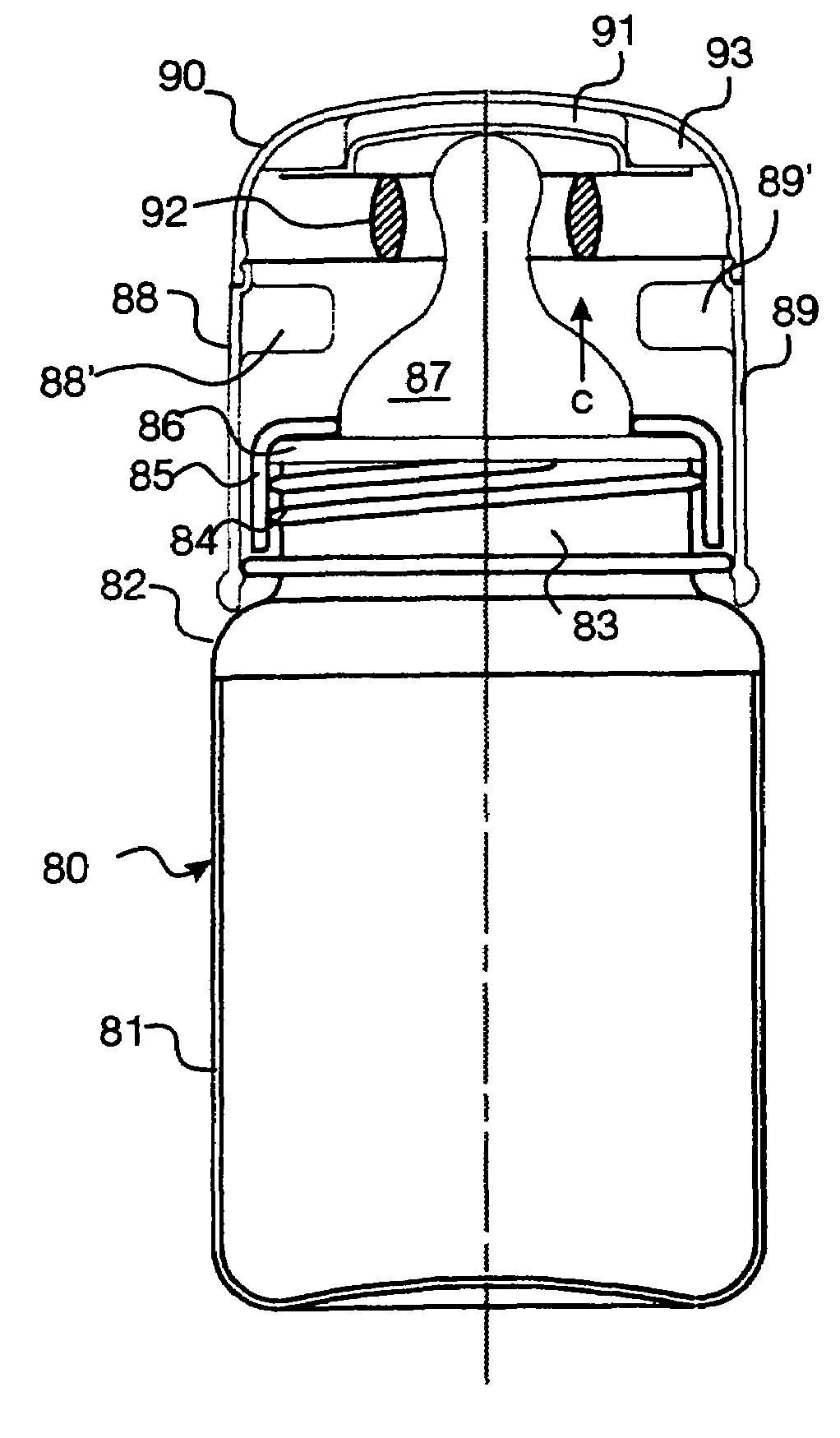[0021]The cap of the invention can take the place of the conventional dormal cap normally supplied with an oral feeding bottle, or can be adapted to receive a conventional dormal cap stowed therein. Preferably the cap of the invention is adapted to be releasably connectable to the feed container in such a manner that the threads surrounding the open end or neck of the feed container can also be treated by the sterilising medium and can be protected from
contamination until all the components of the oral feeding bottle are re-assembled.
Assembly of the components of the oral feeding bottle can conveniently be carried out using the tongs previously referred to, without the need to
handle any of the components.
[0027]It can be seen that, in the method of the invention, the cap of the invention can keep all of the sterilised components of the oral feeding bottle and their surfaces protected until the feed is disposed in the feed container. Even at this stage, by use of the tongs as previously discussed, the teat retaining collar and sealing disc need not be handled, but can be placed in the desired position using the tongs.
[0028]In the preferred method of the invention, in which sterilisation is carried out using steam, preferably by placing the oral feeding bottle within a
microwave oven, the bottle is preferably provided with means for venting excess steam and preventing a build up of pressure within the sterilising chamber formed by the feed container and the cap of the invention. The venting means can comprise, for example, one or more small holes, or apertures in the wall of the cap of the invention. Alternatively, a discontinuity can be provided, in either the cap or the exterior of the feed container, whereby steam can escape between the cap and the exterior wall of the feed container. In one embodiment, for example, the feed container can be provided with a projecting lip or
ridge over which the cap of the invention is a press fit. Discontinuities or recesses in either the cap or the lip at the point of engagement can provide convenient venting means for escape of excess steam and also allow any remaining water to be emptied from the feeding bottle after sterilisation. Alternatively, the cap may be provided with a valve for this purpose.
[0029]In a further embodiment, the cap of the invention can be provided with one or more projecting legs or ledges at one or more sides thereof, whereby the oral feeding bottle can be laid down at an angle to the horizontal to minimise the possibility of water draining out of the neck of the feed container during the sterilisation procedure. This would be more likely to occur if the bottle were laid completely horizontally, as may be necessary in some smaller
microwave ovens. In certain embodiments, the water to be boiled can be placed in the cap of the invention, and the bottle
assembly inverted to stand on the cap, with the feed container extending above it.
[0032]Accordingly, in another preferred embodiment, the cap of the invention is in two separable parts, preferable comprising a body portion and a removable sub-top. The tongs can then be stowed in the sub-top or at the top of the body portion, so that they are visible and readily accessible on removal of the sub-top. The sub-top can be, for example, a press fit on, hinged to, or screwed on, the body portion of the cap. Removal of the sub-top can make it easier, or possible, to use the body portion of the cap to connect the retaining collar to the neck of the feed container without the need to
handle the collar, as previously described.
[0035]In still another preferred embodiment of the invention, the sealing disc is stowed within the cap in such a manner that it blocks the outlet of the feed dispensing means when the feed dispensing means is connected to the feed container. Thus if the feed container containing liquid feed should be knocked over, the sealing disc can prevent or reduce the loss of liquid feed through the outlet of the feed dispensing means. This is yet another separate aspect of the invention. In this embodiment, the sealing disc and the tongs are both preferably stowed in the sub-top. The sealing disc is preferably stowed in the sub-top in such a manner that it can be dislodged by tilting, for example, by applying pressure to one side of a face of the disc.
 Login to View More
Login to View More 


